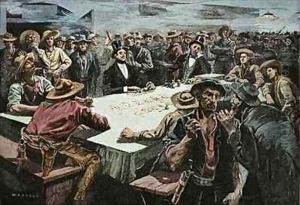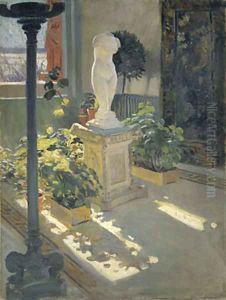William DeLeftwich Dodge Paintings
William DeLeftwich Dodge was an American artist known for his murals, paintings, and illustrations that captured both the dynamic spirit of the Gilded Age and the burgeoning American Renaissance. Born on February 25, 1867, in Liberty, Virginia, Dodge grew up in a period of rapid industrialization and cultural transformation in the United States. His early exposure to art came through his travels in Europe with his family, where he was particularly influenced by the vibrant art scenes in Paris and Munich.
Dodge's formal art education began in Munich at the Royal Academy, where he honed his skills in painting and developed a keen interest in mural painting, a medium that would later define his career. His style was heavily influenced by the grandeur and scale of European historical painting, yet he infused his works with a distinctly American sensibility, focusing on themes of progress, innovation, and the natural beauty of the American landscape.
Returning to the United States in the late 1880s, Dodge quickly established himself as a prominent figure in the American art scene. He was involved in several significant projects, including mural commissions for the Library of Congress, the Administration Building at the World's Columbian Exposition in Chicago in 1893, and the Appellate Court Building in New York City. His murals often depicted allegorical and historical subjects, rendered with a vibrant palette and a dynamic composition that captured the optimism and energy of the era.
Throughout his career, Dodge was also a prolific painter and illustrator, contributing to various magazines and publications, and exhibiting his work at major venues such as the National Academy of Design and the Paris Salon. His paintings often featured landscapes, portraits, and genre scenes, showcasing his versatility and command over different mediums and subjects.
William DeLeftwich Dodge's contributions to American art were not only in his magnificent murals and paintings but also in his role as a mentor and advocate for the arts. He was actively involved in the artistic community, supporting emerging artists and participating in art organizations. Dodge's work remains a testament to the rich cultural landscape of America at the turn of the century, reflecting both the nation's aspirations and its achievements.
Dodge's later years were marked by continued success and recognition, but also by personal challenges and health issues. Despite these difficulties, he continued to work and create until his death on October 25, 1935, in Virginia. Today, William DeLeftwich Dodge is remembered as one of the foremost muralists of his time, whose legacy continues to inspire and captivate audiences with its beauty and historical significance.


